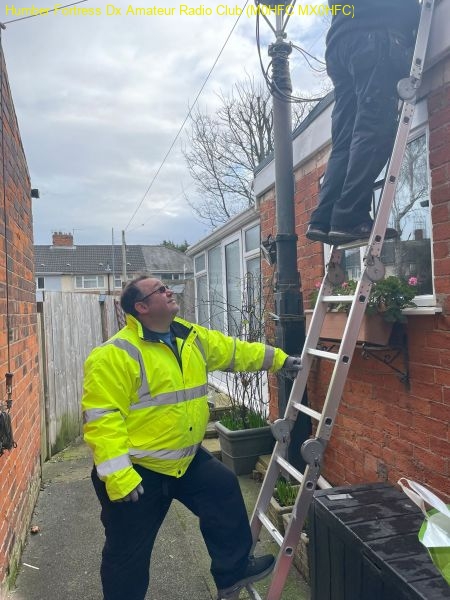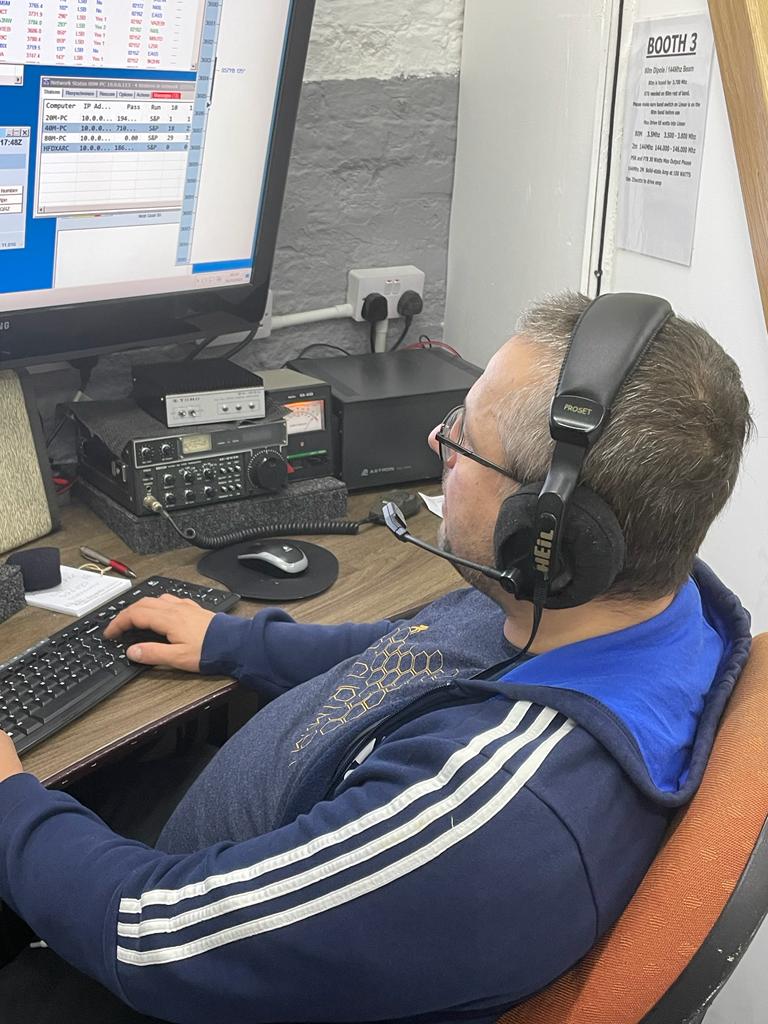Well, what else would you do on cold winter Saturday mornings, well in true Amateur Radio Fashion, Antenna work of course?
Two of our Members Bob M0RWL and John G6LNV required long-awaited help with antenna Works.
Bob required help to install a new 3 element mini beam on his tower.
John required help to install a trapped invert L for 40/80/160 bands.
First up was for Bob M0RWL to install his New 3 Element Mini Beam
Saturday 5th of February saw Steve 2E0NSQ and Andy G7LRR turn up to Bobs M0RWL house at 9:30 am to begin helping him erect his new 3 element mini beam on his tilt-over tower.
Bob had already got his beam 99% built and ready to go. It just required a final fine-tuning which Bob and Steve got on with right away.

The tower was luffed over and the old 2 Element beam which had served Bob well for many years removed.

There was also the rotator in need of repair. This took some time as two 500ohm potentiometer in the feedback circuit was in need of replacement, one in the rotator and the other in the controller. This circuit helps to track the rotator as it rotates the beam. This task was undertaken by Andy G7LRR.

Once the rotator was working, we mounted the new beam and raised the tower again. As luck would have it, Bob and Steve had made a great job in fine-tuning the antenna and no extra was required.

Bob was impressed as the antenna tested on 20m 17m 15m 12m 10m at a low power of 5 watts, easily making contacts into Europe.
This task took the three of us nearly all day but was great fun. Many thanks to Bob and his daughter for providing the nutrition in the form of some great bacon and egg sandwiches, which kept us going throughout.
————————————————————————————————
Next up was Johns G6LNV 40m 80m 160m trapped Inverted L
Saturday 12th of February at 9:00 am; it was a cold and raining day which never stopped.
Kevin M0KVK, John M0JDT, Jason M0MGF, Andy G7LRR turning up at John’s G6LNV house with the aim of sorting John’s wire antennas..
Wrapped up in warm winter clothes, they began the task of getting an inverted L in the sky for 160-40m.
John already had a 20ft support pole at the bottom of his garden and a halyard on his chimney stack; these were put to good use.
At the base of the 20ft pole, we installed a 4ft copper grounding rod into the wet soil.

Next, a counterpoise of 130ft of wire was placed down one side of the garden fence which runs more of else under where the inverted-L is to be positioned.
The base of the connection plate, which was made at the radio club a few weeks prior, was then connected to the earth.

Then it was time for the new run of RG-213 coaxial from the feed-point to the shack at the front of the property.
The trapped Inverted L that had been constructed by Andy G7LRR at the Radio club was hoisted aloft. With the Inverted-L in the air, Kevin M0KVK and Jason M0MGF checked the SWR with an antenna analyser, while John M0JDT and Andy G7LRR made adjustments to result in good readings for the said bands.

Once 40m, then 80m, and finally 160m was completed, the connections were all soldered and sealed, and the antenna hoisted high in the air and secured.
Now complete, It is all for John to rebuild his shack and to re-connect up his radio, then we can all hear how well it is working.
Although it was a cold and damp day, with the team effort we succeeded in getting Johns Inverted-L up
Well done to all that helped our members in need.
It was great getting back out and helping those in need after all the Covid-19 lockdown periods and to see the club working as a team.
Related Images:
Like this:
Like Loading...








































You must be logged in to post a comment.